Cat hunting behavior refers to your cat’s natural instincts when they chase, catch, and often play with prey animals and insects. Hunting is perfectly normal behavior and is just your furry friend acting on her natural instincts; you’ll even see it in house cats and wild big cats!
But why does your feline friend suddenly transform from a purring, cuddly lap cat into a miniature tiger when a toy, or even a real critter, dashes across its path? The urge to hunt is embedded deep in your cat’s DNA, harking back to her wild ancestors. Hunting isn’t just about finding and catching food; it’s about survival, play, and honing a very special set of skills.
Although hunting is instinctual, the act itself is a feline art, often taught and refined over time. Kittens typically learn by watching their mothers, engaging in playful mock battles with their siblings, and playing solo with toys. When my two cats were kittens, they would often play-fight and stalk each other, one hiding under the sofa and leaping out to catch the other unaware!
From birds to bugs and from rodents to reptiles, cats have a wide variety of prey. Most cat owners have watched their cats chasing butterflies and bees in the garden, and many have found a bedraggled, furry “present” on the doormat in the morning.
If you’re concerned about your cat’s hunting escapades, especially if she insists on bringing home unwanted “gifts,” there are ways you can mitigate your pet’s behavior. However, you must approach that with an understanding of their natural instincts.
Intrigued? Read this guide to learn more about your cat’s hunting instincts and discover how to protect your local wildlife without spoiling Kitty’s fun!
What Causes Cat Hunting Behavior?
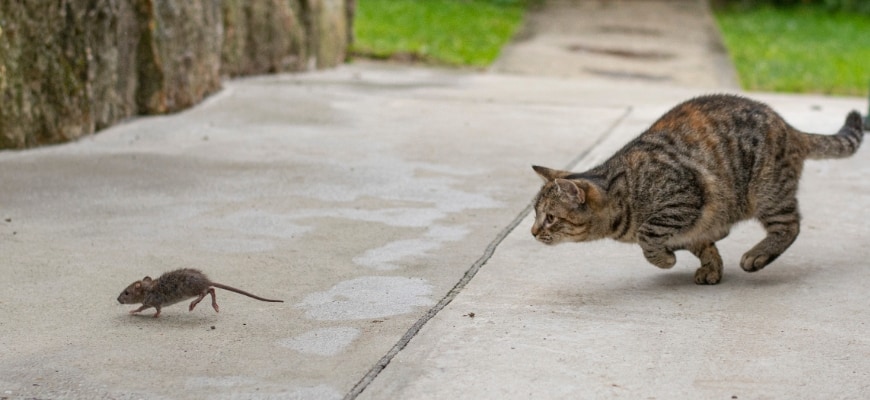
Cats hunt because of their evolutionary history as well as their natural instincts.
Here are some key factors that explain why your cat loves the thrill of a good hunt!
Instinct
Your cat’s hunting behavior is largely driven by her natural instincts, which have evolved over many thousands of years. Cats are descendants of solitary hunters, and their hunting skills were essential for survival in the wild. Today, even domestic moggies and pedigree feline divas retain these instincts, which often manifest as hunting behavior.
Prey Drive
Your cat’s prey drive is what drives your cat to chase, catch, and eat small animals, reptiles, and insects. Essentially, your cat is hardwired to track moving objects, pounce on them, and use her claws to grab and hang on to prey.
Even though you feed your pet and she’s not hungry, her prey drive remains intact, and she still displays hunting behaviors towards toys, insects, or even household items, such as your fuzzy novelty slippers!
Hunger
As mentioned above, although your pampered pussycat gets regular meals, her hunting behavior can also appear if she’s hungry. So, cats that live on farms or stableyards are often not fed, so they are more likely to catch mice, rats, and other vermin, essentially working for their bed and board!
Play Behavior
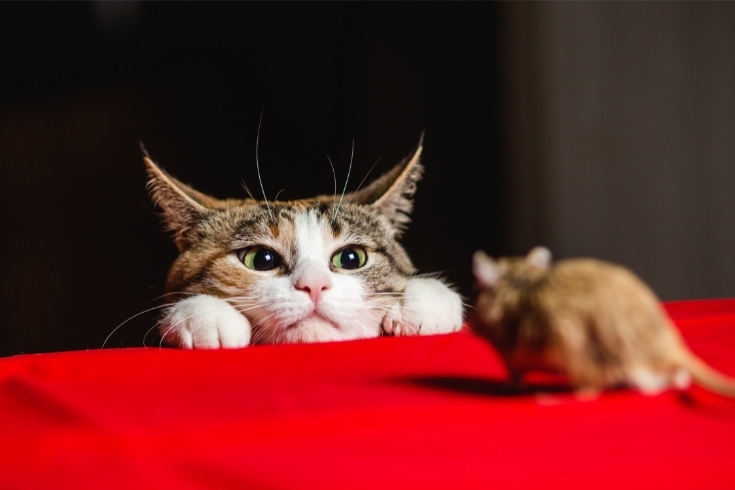
Much of your cat’s hunting behavior can be chalked up to playtime. Kittens especially hone their hunting skills through play, such as pouncing, sneaky stalking, and playfully batting at toys. Those mock hunts fine-tune your cat’s coordination, lightning-fast reflexes, and fancy moves, all of which come in handy when she’s on the prowl through the “jungle” of her backyard.
Even adult cats still get into the whole playful hunting routine, keeping themselves mentally sharp and physically fit at the same time.
Territorial Instincts
As you know, cats are territorial creatures, and hunting is a highly effective way of marking out and defending a territory. Cats mark their patch with their scent by patrolling and hunting within it and discouraging other animals from making a takeover bid.
You’ll especially see that behavior in outdoor and feral cats, as they must defend their territory against competitors for food and mates.
How Do Cats Learn To Hunt?
Cats learn to hunt through a variety of means, including natural instinct, experience, watching other feline hunters, and trial and error.
So, just how does your feline friend learn how to turn from a purring, fluffy softie into a vicious killer?
Observation
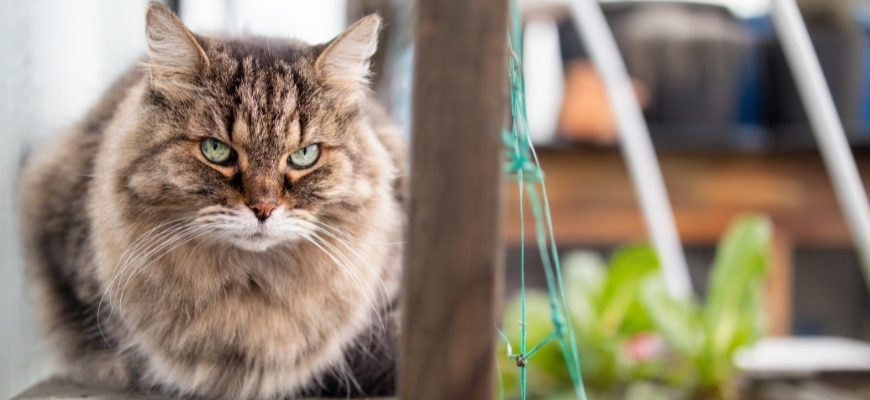
Cats learn a lot by watching other cats’ and animals’ behavior and copying it. That’s especially evident in kittens who closely observe their mothers from a very young age. A mother cat often demonstrates hunting behaviors, such as stalking, pouncing, and catching prey, and through observation, kittens get a first-hand lesson in the art of the hunt.
Play
A kitten pouncing on a ball of yarn is undoubtedly cute to watch, but this “play” is actually an essential part of the little guy’s hunting education.
Through play, kittens can practice the physical actions and strategies they’ll use in real hunting situations but without the risk. Each swipe at a dangling feather or pounce at a rolling ball is a step closer to perfecting their hunting prowess, and it’s also great fun!
Trial And Error
As in any learning process, cats must experiment to find out what hunting techniques work and which don’t. Your cat might not make a successful pounce or catch their prey on the first try, but each missed attempt provides valuable feedback, and eventually, through trial and error, your furry friend refines her techniques and becomes a more effective hunter.
Experience
They say there’s no better teacher than experience, and that’s certainly true for your cat! As your cat encounters various real-life prey items, from bugs to birds, she gathers a wealth of knowledge about different hunting strategies.
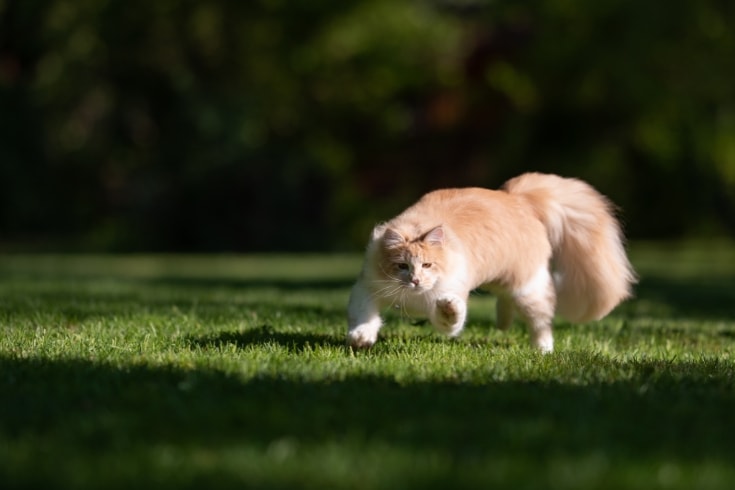
Each hunt, whether successful or not, offers a lesson, and over time, your cat’s hunting skills become honed and sharpened, transforming her from a curious kitten into an adept hunter who’s the scourge of the local wildlife!
Maturation
As cats mature, their physical and cognitive skills develop, enhancing their hunting abilities. A fully grown cat has the strength, speed, and stealth required for successful hunting. In addition, your pet’ senses, particularly sight, smell, and hearing, are at their peak, aiding your feline friend in detecting and tracking prey.
Instinct
Of course, we can’t discuss any cat’s hunting prowess without talking about the species’ natural instinct. While observation and learning definitely play significant roles, much of your cat’s hunting behavior is hard-wired into her DNA, so even without watching examples and experiential learning, a cat has an inbuilt understanding of what hunting techniques work.
How Do Cats Hunt?
Cats hunt using a variety of fascinating techniques that are entertaining to watch. Generally, your cat starts her hunting journey during kittenhood by chasing, pouncing on balls, and learning to leap up and grab feather wand toys.
As your cat gets older, she might progress to hunting live prey, such as spiders and butterflies, before graduating to mice, garden birds, and even larger prey like rabbits.
Cat Stalking
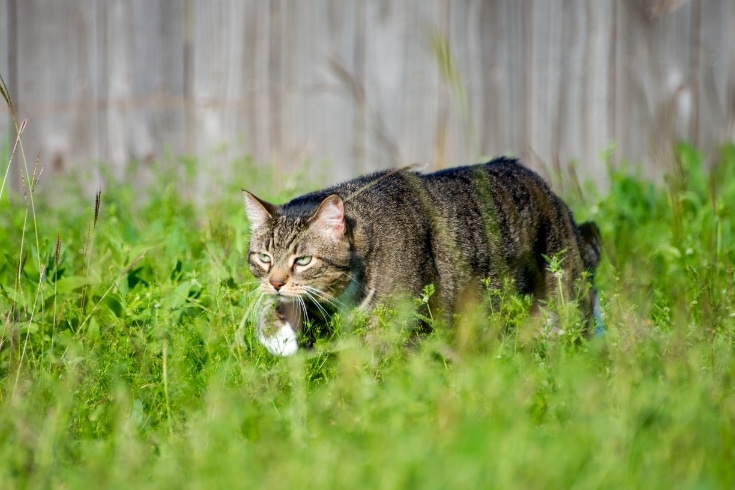
When your cat finds her target, she lowers her body, almost hugging the ground, and slowly inches towards her target. This stealthy leopard crawl move helps the hunter avoid detection, blending in with their surroundings. Of course, for indoor cats and young kittens, the “prey” might be your unsuspecting foot moving under a blanket!
Using Senses
Your cat’s senses are fine-tuned hunting instruments. Her whiskers detect even the slightest air currents, alerting her to the movement and breathing of nearby prey; her ears swivel independently, catching the faintest rustle of a tiny mouse scurrying through the long grass. And those piercing eyes? They’re adept at sensing even the tiniest movements, especially during dusk and dawn, the cat’s prime hunting hours in the wild.
Pouncing
If you’ve ever been entertained by your cat suddenly leaping into the air and landing on an unsuspecting target, you’ve seen the pounce in action. The pounce uses a combination of stealth, precision, and athleticism. The cat coils her body, gets ready, and in one swift motion, leaps onto her prey in a skill perfected over countless generations.
Fishing
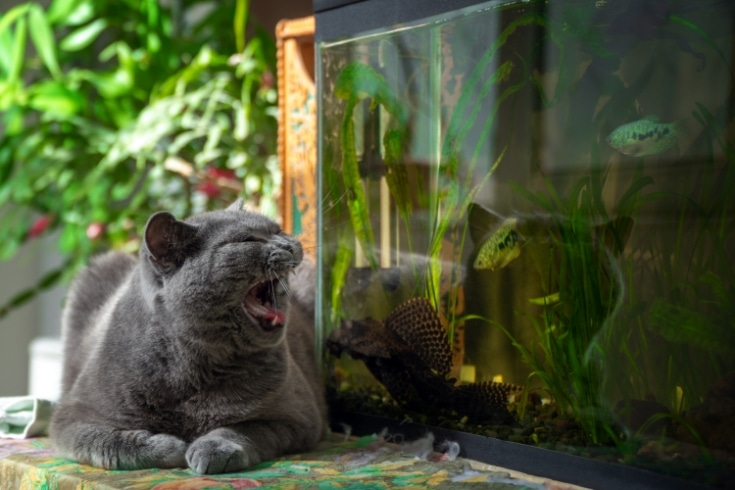
Did you know that some cats can fish? Although not all felines enjoy getting wet, some have been known to bat at fish in ponds, and if you have a pond or an aquarium at home, you might have noticed your kitty’s undivided attention to the aquatic inhabitants!
In my home, the fish tank is nicknamed the “cats’ TV” because my two furry friends spend ages gazing at the fish gliding past and occasionally reaching out with a curious paw. Needless to say, my aquarium has a tightly fitting lid!
Capturing Prey
The culmination of a successful hunt is the capture of the prey. Cats use their sharp, retractable claws and quick reflexes to snag their prey and keep a tight hold on it. Many times, indoor cats hunt prey using toys, clutching the captured toy tightly and kicking it with their hind legs to mimic the actions of their wild cat relatives.
Playing With Prey
Although it might seem cruel to us, cats often play with their captured prey. However, that distasteful behavior isn’t purely for the cat’s amusement. In the wild, playing with a catch is a tactic designed to wear out and disorient the prey to ensure it can’t retaliate or escape. Even when presented with inanimate toys, domestic cats often exhibit this same behavior, tossing their prey around and batting at it.
Consuming The Prey
Cats are obligate carnivores, meaning their diet is primarily composed of meat. Wild cats hunt to provide food for themselves and their offspring, and too many unsuccessful hunts can sometimes result in starvation, especially during seasons when prey is scarce.
In a survival mechanism, ensuring they gain vital nutrients, cats typically start by eating the prey’s head, followed by the rest of the body, which is why you’ll often find a headless rodent discarded on your patio. Yuk!
Why Do Cats Play With Their Prey?
Cats play with their prey for a couple of important reasons: to tire it out and check that what they’ve caught is healthy and free from disease.
Allows The Cat To Check If The Prey Is Healthy
When your cat snags prey, she might play with it to assess its health.
Healthy prey might still have the strength to injure the cat or escape, while weaker or sickly prey poses less risk. By batting at, tossing, or otherwise engaging with their prey, your cat can gauge the vitality and strength of their catch.
Playing With Prey Tires It Out Before It Is Killed
When a cat captures prey, the prey might still have a lot of energy and could potentially harm the cat or escape. By playing or toying with the prey, the cat can exhaust and disorient it, making it less likely to fight back or run away, making for a safer and more efficient kill for the cat.
What Do Cats Hunt
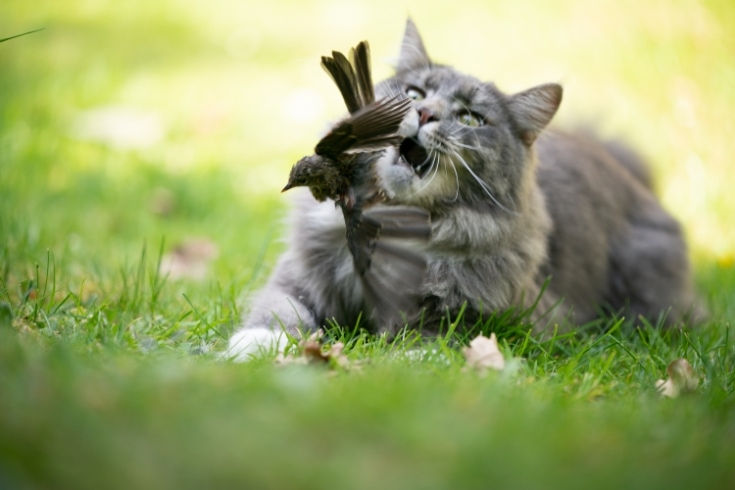
Cats hunt a surprisingly wide variety of prey, from flies and spiders in your home to songbirds, mice, and even frogs, snakes, and rabbits in your backyard. The size of the cat seems to be irrelevant to the size of the prey item. For example, a friend of mine owns a Bengal cat that regularly drags full-grown rabbits, wild pigeons, and, once, a live chicken into his house through the catflap!
Small Rodents
Unfortunately for the local mouse population in your area, these tiny scurrying creatures are a constant source of fascination for most cats, and many end up as prey items.
Mice
A quintessential quarry for cats, mice are nimble and quick, making them a challenging catch for even the most skilled feline hunter.
Rats
Larger than mice, rats can be both a source of fascination and caution for cats. Rats are intelligent, large, and have sharp teeth, making them formidable opponents in the game of cat and mouse!
Rabbits
Rabbits are not on the menu for many domestic cats, although I once owned a former farm cat who would kill and bring home baby rabbits to feed her kittens before I adopted her.
Birds
Birds are another prey group on your feline friend’s radar. The unpredictable fluttering movements and chirping noises can keep a cat entertained for hours. My cats both love to watch cat TV stations on YouTube and their favorite “actors” are the feathered kind!
Sparrows
These small, agile birds are commonly found in gardens and backyards. Their quick flight and happy chirping from the hedgerow can quickly draw a cat’s attention.
Finches
Often known for their vibrant colors, finches are another bird species that might tempt your cat’s predatory side, especially if they flutter around bird feeders in your garden.
Songbirds
Songbirds come in many sizes and colors, depending on your region, but all can be a magnet for hunting cats, seemingly captivated by the bird’s bubbling chorus at dusk and dawn.
Insects
Insects might not make a substantial meal, but they can be an exciting diversion for cats, offering hours of playful chasing, and are often a good starting point for kittens learning their trade.
Flies
Buzzing around and often within a paw’s swipe, flies can be an amusing target for playful cats, especially when they’re trapped indoors. My cats love to stalk and catch flies in my conservatory and are surprisingly adept at grabbing these speedy prey items.
Moths and Butterflies
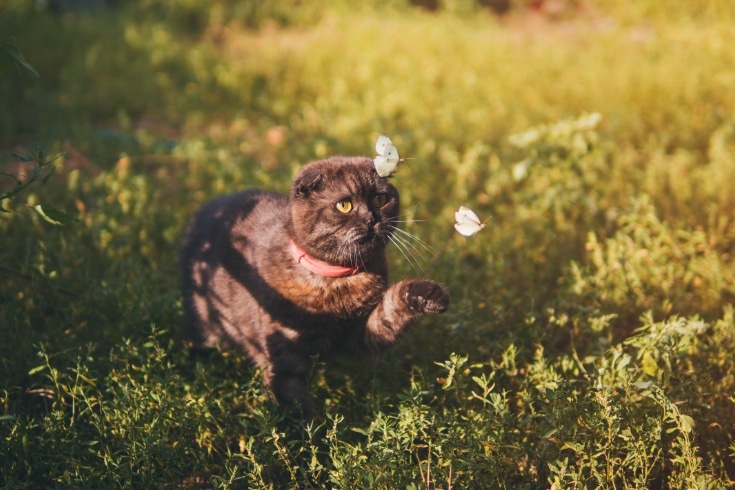
The unpredictable fluttering of moths and butterflies can make challenging targets for cats. I’ve watched my cats jump several feet off the ground to snatch a butterfly in mid-flight, which is really something to see!
Grasshoppers
Their unpredictable, erratic jumping makes grasshoppers fun for a hunting cat to chase on a warm summer’s evening.
Spiders
Many cats enjoy hunting spiders and will often enjoy munching on a tasty arachnid if the hunt is successful. However, ensuring spiders in your area aren’t toxic to felines is essential before you allow your cat to set off in pursuit of an eight-legged prey item.
Lizards And Reptiles
Lizards and other small reptiles can be enticing targets for cats, often provoking a playful or hunting response when encountered in your backyard. Most reptiles are harmless to cats, although some regions are home to venomous snakes, which could be a deadly target.
Skinks
These small, shiny lizards with sleek bodies might catch your cat’s eye as they dart across open spaces or bask in the sun on your patio.
Geckos
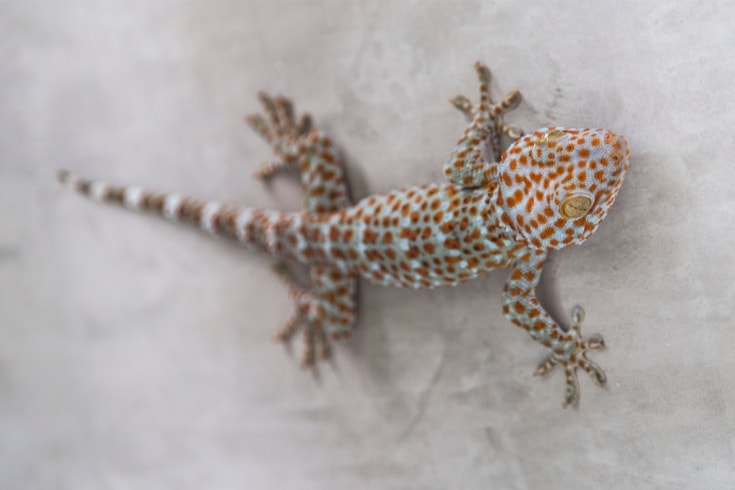
You often see geckos on walls or ceilings at night, and their quick and jerky movements can entertain and intrigue curious cats.
Whiptails
These lizards, known for their long tails and rapid movements, can be a challenging prey item for any cat looking for a playful chase.
Anoles
Common in some regions, anoles are tiny lizards that can change color as camouflage, presenting a challenge to a feline hunter.
Fence Lizards
Fence lizards can be tantalizing for any passing cat with their spiny backs and tendency to bask openly in the sun.
Fish
If you have a garden pond containing goldfish, you might spot your cat sitting at the water’s edge, watching the surface closely and batting a hopeful paw at a passing fish. A domestic aquarium can also be a fascinating temptation for a cat, so if you have a fish tank, always put a lid on it!
Invertebrates

As well as common insects, other invertebrates might also tickle a cat’s fancy, sparking both their curiosity and playful nature.
Snails
Snails don’t make a particularly challenging prey item for the average cat, although kittens are often fascinated by the snail’s habit of disappearing into its shell when poked with a curious paw.
Earthworms
Often wriggling on wet surfaces after rains, earthworms and similar creepy crawlies might attract a cat’s attention, but most felines will leave them be after a brief investigation.
How To Stop Cats Hunting?
To stop cats from hunting, you must understand your pet’s natural instincts and offer her some alternative ways to express these behaviors without harming other animals.
Here are some strategies that you can try!
Redirect Hunting Instincts Through Play
One of the best ways to redirect your cat’s hunting energy is through play, so invest in a few toys that mimic the movement of birds, mice, or insects.
For example, a feather wand can replicate a bird’s flight, and battery-operated toys can mimic the scurrying of a mouse.
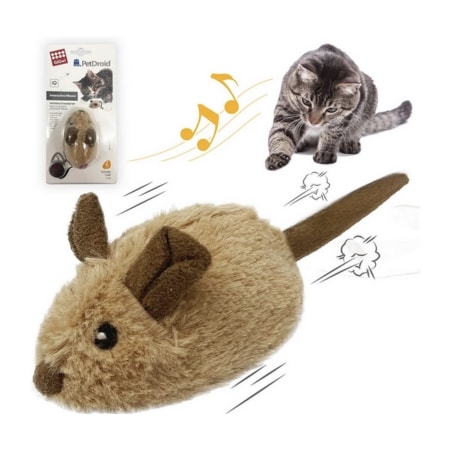
Get Them A Collar With A Bell On It
A highly effective way to prevent carnage in your back garden is to fit your cat in a collar with a bell. That way, potential victims will hear your cat coming before she gets close enough to pounce.
However, be sure the collar is a breakaway type to prevent any potential risks if the collar gets caught on something.

Make Sure They’re Getting Enough Food
A cat will hunt for food if she’s hungry, so by ensuring your cat is fed a balanced and satisfying diet, you can reduce her need to catch prey items to eat. That doesn’t mean your kitty won’t hunt at all, but it might reduce the frequency of her attacks on local wildlife.
Keep Them Inside At High Activity Times
Dawn and dusk are prime hunting times for cats, so if you’re concerned about your cat heading off on hunting trips, consider keeping her indoors during these periods. That protects potential prey and keeps your cat safe from possible dangers like traffic or predators.
Consult With A Veterinarian Or Animal Behaviorist
If you’ve tried several hunting prevention strategies, but your cat persists in chasing and catching innocent creatures in your backyard, you might need to seek expert advice from your vet or an animal behaviorist.
These experts can provide valuable insights into why your cat behaves in the way she does and might offer specialized hunting prevention solutions tailored to your pet.
Neuter Or Spay Your Cat
Hormones can play a significant role in your cat’s hunting behavior, and neutering or spaying your cat can often reduce her urge to roam and hunt. Moreover, desexing your cat comes with additional benefits, like preventing unwanted litters and reducing the risk of your pet contracting and spreading certain diseases.
Remember, hunting is a natural instinct for cats, so the goal isn’t to eliminate this behavior altogether but rather to manage it in a way that’s harmonious with our own lives and the environment.
FAQs
In this part of our guide, we answer some of the most frequently asked questions about cat hunting behavior.
How Do Mother Cats Teach Their Kittens To Hunt?
Watch a mother cat and her kittens; you could be treated to a masterclass in Hunting 101! Mom will start by bringing back dead critters and giving them to her kittens to play with. As the little furballs get more confident, their mother ups her game and fetches them something that’s still alive and kicking to allow the kittens to practice their pounce and takedown technique.
When the kittens are older, they will follow their mother and copy her behavior, catching their own harmless prey items, such as insects.
Can I Train My Cat Not To Hunt Birds?
Yes, there are a few ways of training your cat not to hunt birds, although you’re in for a challenge! The key is to redirect your cat’s attention away from the birds by playing with her, ideally with a feather wand toy or something similar.
Also, as mentioned above, bell collars can be a game-changer. The birds will hear your cat coming and have a chance to fly to freedom. However, remember, hunting is in your cat’s nature, so it’s more about managing than eliminating the behavior.
Do All Cats Have Strong Hunting Instincts?
Yes, most cats have that inner wildcat vibe and are wannabe expert hunters. However, just like humans, not all cats are into the same hobbies. Some felines might prefer to laze around all day, while others have that fierce inner hunter. It’s all down to a mix of genetics and environment.
Are There Risks Associated With Outdoor Hunting For Cats?
Yes, unfortunately, there are risks associated with outdoor hunting for cats. When cats are out prowling, they might run into bigger predators, pick up parasites, or even get hurt by prey that fights back, and don’t forget the risk of cars or getting lost. It’s a jungle out there, even in the suburbs!
How Can I Satisfy My Cat’s Hunting Instincts Indoors?
The best way to satisfy your cat’s hunting instincts indoors is by providing her with a selection of toys, especially move or squeak. Laser pointers, feather wands, or motorized rats and mice can give your fluffy friend the thrill of the hunt without the messy ending!
Can Neutering Or Spaying Affect Hunting Behavior?
As mentioned earlier in this article, having your cat neutered or spayed can help mellow them a bit, although it doesn’t necessarily mean your pet will hang up their hunting boots altogether!
Is It Ethical To Allow Cats To Hunt?
The ethics behind cats and hunting is something of a hot debate.
On one side of the fence, hunting is a natural behavior for cats, which helps to exercise your cat mentally and physically and is also a natural stress reliever. However, a hunting cat can wreak havoc on local wildlife, which doesn’t go down well with people who love to watch the birds in their gardens.
In addition, there are those risks we talked about. Essentially, it’s all about finding a balance, like maybe supervised outdoor time or using deterrents, such as a bell collar to protect birds or keeping your cat indoors at prime hunting times.
At the end of the day, everyone’s got an opinion, so do what feels right for you and your furry friend.
Conclusion
Cats are born with hunting in their DNA. The wild cats from whom your domestic moggy is descended hunted to provide their kittens with food and had many centuries to perfect their hunting techniques.
Mother cats teach their kittens how to hunt from a very early age, and even house cats enjoy the thrill of the chase, often chasing and catching flies and other insects inside your home. It’s pretty much impossible to stop your cat from hunting, as that behavior is hard-wired into her psyche. However, you can minimize the decimation of your local wildlife population by fitting your cat with a bell collar to warn potential prey of incoming danger or keeping your kitty indoors during the prime hunting times of dawn and dusk.
You can provide your cat with valuable exercise and mental stimulation and satisfy her hunting desires by buying a selection of toys that she can chase, pounce on, and grab. That way, your cat is kept happy, and the wildlife in your neighborhood can rest easy!